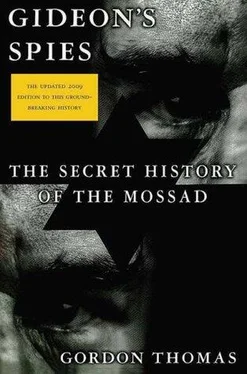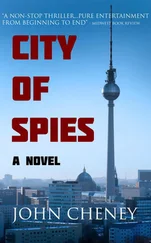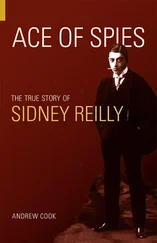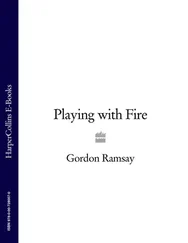Gordon Thomas - Gideon's Spies
Здесь есть возможность читать онлайн «Gordon Thomas - Gideon's Spies» весь текст электронной книги совершенно бесплатно (целиком полную версию без сокращений). В некоторых случаях можно слушать аудио, скачать через торрент в формате fb2 и присутствует краткое содержание. Город: New York, Год выпуска: 2009, ISBN: 2009, Издательство: Thomas Dunne Books, Жанр: История, на английском языке. Описание произведения, (предисловие) а так же отзывы посетителей доступны на портале библиотеки ЛибКат.
- Название:Gideon's Spies
- Автор:
- Издательство:Thomas Dunne Books
- Жанр:
- Год:2009
- Город:New York
- ISBN:978-0-312-53901-6
- Рейтинг книги:4 / 5. Голосов: 1
-
Избранное:Добавить в избранное
- Отзывы:
-
Ваша оценка:
- 80
- 1
- 2
- 3
- 4
- 5
Gideon's Spies: краткое содержание, описание и аннотация
Предлагаем к чтению аннотацию, описание, краткое содержание или предисловие (зависит от того, что написал сам автор книги «Gideon's Spies»). Если вы не нашли необходимую информацию о книге — напишите в комментариях, мы постараемся отыскать её.
Gideon’s Spies
Gideon's Spies — читать онлайн бесплатно полную книгу (весь текст) целиком
Ниже представлен текст книги, разбитый по страницам. Система сохранения места последней прочитанной страницы, позволяет с удобством читать онлайн бесплатно книгу «Gideon's Spies», без необходимости каждый раз заново искать на чём Вы остановились. Поставьте закладку, и сможете в любой момент перейти на страницу, на которой закончили чтение.
Интервал:
Закладка:
Rafi Eitan returned to Tel Aviv to await results. They exceeded his wildest expectations: details of Russian arms deliveries to Syria and other Arab states, including the precise location of SS-21 and SA-5 missiles; maps and satellite photographs of Iraqi, Syrian, and Iranian arsenals, including chemical and biological manufacturing plants.
Rafi Eitan quickly obtained a clear picture of U.S. intelligence-gathering methods, not only in the Middle East, but in South Africa. Pollard had provided reports from CIA operatives which provided a blueprint for the entire U.S. intelligence network within the country. One document contained a detailed account of how South Africa had managed to detonate a nuclear device on September 14, 1979, in the southern end of the Indian Ocean. The Pretoria government had steadfastly denied it had become a nuclear power. Rafi Eitan arranged for Mossad to pass over copies of all material relating to South Africa to Pretoria, virtually destroying the CIA network. Twelve operatives were forced to hurriedly leave the country.
During the next eleven months, Jonathan Pollard continued to asset-strip U.S. intelligence. Over one thousand highly classified documents, 360 cubic feet of paper, were transmitted to Israel. There Rafi Eitan devoured them before passing over the material to Mossad. The data enabled Nahum Admoni to brief Shimon Peres’s coalition government on how to respond to Washington’s Middle East policies in a manner previously impossible. One note taker at the Sunday cabinet meetings in Jerusalem claimed that “listening to Admoni was the next best thing to sitting in the Oval Office. We not only knew what was the very latest thinking in Washington on all matters of concern to us, but we had sufficient time to respond before making a decision.”
Pollard had become a crucial factor in the mysteries of Israeli policymaking and the intricacies of choosing options. Rafi Eitan authorized an Israeli passport for Pollard in the name of Danny Cohen, as well as a generous monthly stipend. In return he asked Pollard to provide details about the electronic eavesdropping activities of the National Security Agency (NSA) in Israel and the bugging methods used against the Israeli embassy in Washington and its other diplomatic stations within the United States.
Before Pollard could supply the information he was arrested, on November 21, 1985, outside the Israeli embassy in Washington. Hours later Yagur, Sella, and the embassy secretary in Washington had all caught an El Al flight from New York to Tel Aviv before the FBI could stop them. In Israel they disappeared into the protective arms of a grateful intelligence community. Pollard was sentenced to life imprisonment and his wife to five years.
In 1999, Pollard could draw comfort from the tireless way powerful Jewish groups lobbied for his release. The Conference of Major American Jewish Organizations, a consortium of over fifty groups, had launched a sustained campaign to have him set free on the grounds that he had not committed high treason against the United States “because Israel was then and remains today a close ally.” Equally influential Jewish religious groups such as the Reform Union of American Hebrew Congregations and the Orthodox Union, lent support. The Harvard Law School professor Alan M. Dershowitz, who had been Pollard’s attorney, said there was nothing to show the spy had actually compromised “the nation’s intelligence-gathering capabilities or betrayed worldwide intelligence data.”
Alarmed at what they realized was a skilled public relations campaign orchestrated from Israel, the U.S. intelligence community took an unusual step. They moved out of the shadows into the public domain, setting out the facts of Pollard’s treachery. It was both a bold and dangerous decision. It would not only cast a light on sensitive material but also mobilize the evermore powerful Jewish lobby to attack them. They had seen what it had done to others in the frenetic atmosphere of Washington. A reputation could be discreetly tarnished over a late drink at an embassy between acts at the Kennedy Center or over a quiet Georgetown dinner.
Those intelligence men feared that Clinton—“in one of his quixotic moments,” a senior CIA officer told me—would free Pollard before he left office if that would ensure Israel entered into a peace settlement and give Clinton a last foreign policy success. The CIA’s director at the time of writing, George Tenet, had warned the president “that Pollard’s release will demoralize the intelligence community,” Clinton was reported to have merely said: “We’ll see, we’ll see.”
In Tel Aviv, Rafi Eitan has closely followed every move, telling friends that “should the day come when Jonathan makes it to Israel, I’d be happy to have a cup of coffee with him.”
Meantime Eitan continued to rejoice at the success of another operation he had also mounted against the United States. It led to Israel’s becoming the first nuclear power in the Middle East.
CHAPTER 5
GIDEON’S NUCLEAR SWORD
In the darkness of a Tel Aviv cinema in 1945, Rafi Eitan had watched the birth of the nuclear age over Hiroshima. While all around him young soldiers whistled and cheered at the newsreel footage of the devastated Japanese city, he had only two thoughts. Would Israel ever possess such a weapon? Suppose her Arab neighbors obtained one first?
From time to time down the years the questions had surfaced in his mind. If Egypt had had a nuclear bomb, it would have won the Suez War and there would have been no Six Day War or Yom Kippur War. Israel would have been a nuclear desert. With a nuclear weapon, Israel would be invincible.
In those days, for an operative whose work was primarily concerned with killing terrorists, such strategic questions were only of academic interest and answering them was the province of others. However, when he took command of LAKAM, he began to seriously consider the matter. He now only had one question: Could he help to provide Israel with a nuclear shield?
Reading long into the night, fueled by the forty vitamin capsules he swallowed each day, he discovered how Israel’s politicians and scientists had initially been divided over “going nuclear.” In the files were details of angry exchanges within cabinet meetings, the bitter monologues of scientists, and always the overpowering voice of Prime Minister David Ben-Gurion cutting through the anguish, protests, and long-winded arguments.
Trouble had begun in 1956, when France had sent a twenty-four-megawatt reactor to Israel. Ben-Gurion announced its purpose was to provide a “pumping station” to turn the desert into an “agricultural paradise by desalinating a billion cubic gallons of seawater annually.” The claim promptly led to the resignation of six of the seven members of the Israeli Atomic Energy Commission, protesting the reactor was actually intended to be the precursor of “political adventurism which will unite the world against us.” Israel’s leading military strategists supported them. Yigal Allon, a hero of the War of Independence, roundly condemned the “nuclear option”; Yitzhak Rabin, who would soon become the IDF chief of staff, was equally vocal in his protest. Even Ariel Sharon, then Israel’s leading hawk, vehemently opposed a nuclear arsenal. “We have the best conventional forces in the region.”
Ignoring all opposition, Ben-Gurion gave the order for the reactor to be sited in the Negev Desert, close to the bleak, sand-blown settlement at Dimona. Once a staging post on the camel caravan route between Cairo and Jerusalem, Dimona had long become a place time had passed by. Few maps marked its position in the desert south of Tel Aviv. But from now on no mapmaker would be allowed to pinpoint the location of Israel’s first faltering steps into the nuclear age.
Читать дальшеИнтервал:
Закладка:
Похожие книги на «Gideon's Spies»
Представляем Вашему вниманию похожие книги на «Gideon's Spies» списком для выбора. Мы отобрали схожую по названию и смыслу литературу в надежде предоставить читателям больше вариантов отыскать новые, интересные, ещё непрочитанные произведения.
Обсуждение, отзывы о книге «Gideon's Spies» и просто собственные мнения читателей. Оставьте ваши комментарии, напишите, что Вы думаете о произведении, его смысле или главных героях. Укажите что конкретно понравилось, а что нет, и почему Вы так считаете.












